Neon tetra (lat. Paracheirodon innesi) is a kind of freshwater fish from Characidae family and it is the most popular aquarium species. Except its attractive appearance, the fish is also peaceful and has high adaptivity, i.e. it doesn’t require any specific care.
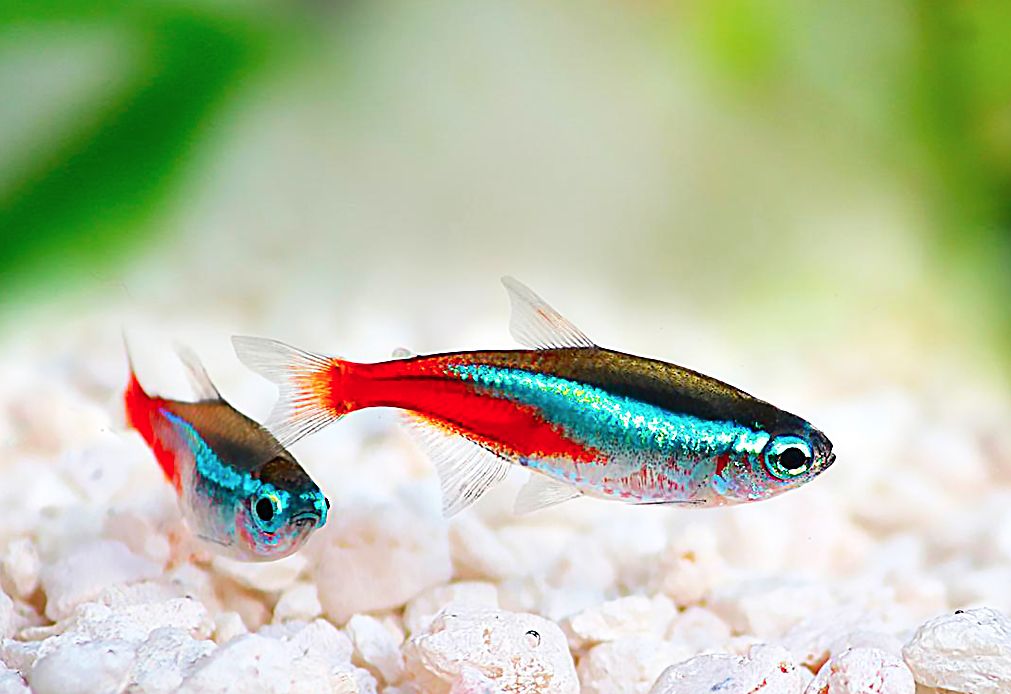
Contents
Habitat in the wild
Neon tetras are native to the blackwater streams and tributaries of the Amazon River basin in South America. They are specifically found in parts of Brazil, Colombia, and Peru. In their natural habitat, neon tetras inhabit slow-moving waters, particularly in areas with dense vegetation and submerged tree roots. The water in these regions is typically soft, acidic, and stained brown due to the presence of tannins and other organic materials. These are rivers with dark water that flow through the thick rain forest, so very small amount of sunlight gets into the water. The neon tetras lives in schools, inhabits in the middle water layers and feeds on different insects.
Neon tetras belong to the Characidae family, which is a large family of freshwater fish commonly known as characins. The scientific name for the neon tetra is Paracheirodon innesi. Characidae is a diverse family that includes many popular aquarium fish, known for their vibrant colors, active behavior, and ease of care.
Some other well-known members of the Characidae family include:
- Cardinal Tetra (Paracheirodon axelrodi) – Similar to the neon tetra but with a red stripe that extends the entire length of its body.
- Black Neon Tetra (Hyphessobrycon herbertaxelrodi) – A close relative of the neon tetra with a similar body shape but a black stripe instead of blue.
- Serpae Tetra (Hyphessobrycon eques) – Recognizable by its red body with black markings.
- Rummy Nose Tetra (Hemigrammus rhodostomus) – Known for its striking red nose and black tail fin.
- Bleeding Heart Tetra (Hyphessobrycon erythrostigma) – Identified by a red spot on its body that resembles a “bleeding heart.”
History
Neon tetra was discovered in 1934 by French traveler August Rabaut during his expedition around the Amazon jungles. He enjoyed the sparkling fishes he accidentally caught and decided to bring them to Europe for selling. Europeans became big fans of the fish, but for some period of time it didn’t have any official name. In 1935 some species got to the famous popularizer of aquarium husbandry and also a journal editor William T. Innes, who gave the fishes to his colleague, Dr. George Myer.
As a result the first official article about neon tetrawas published in Biological Society Bulletin in Washington in 1936. Dr. George Myer, the author of the article named the new fish kind by the surname of his colleague – Hyphessobrycon innesi. Later, the neon tetra kind was renamed into Paracheirodon inessi.
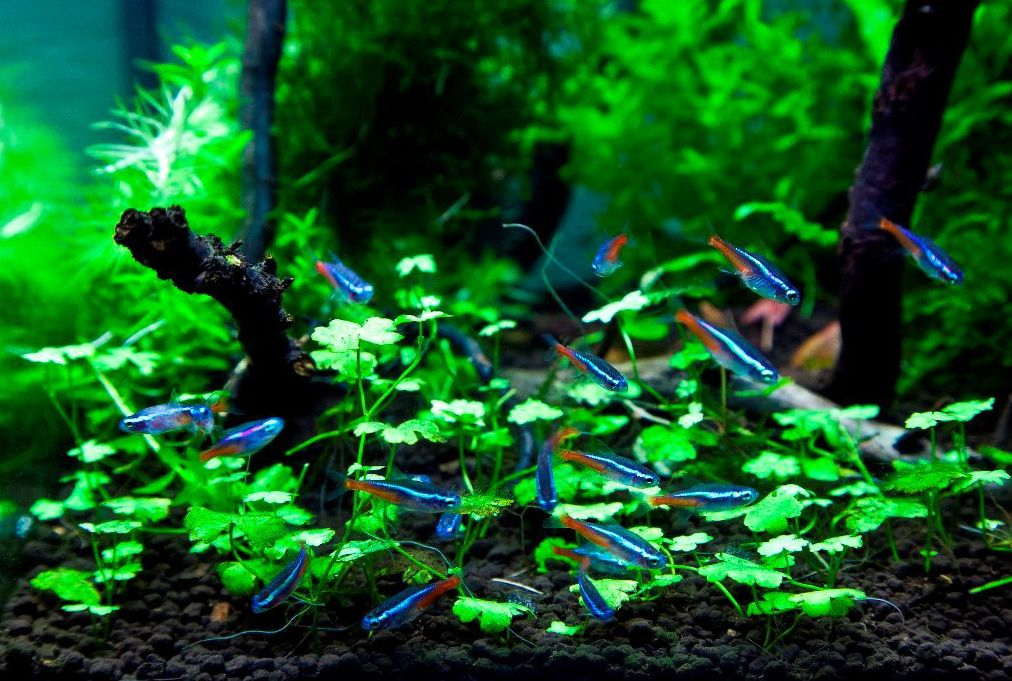
Description
Body
The body of a neon tetra is relatively small and slender, with a streamlined shape. Their mouth is small and terminal, located at the front of the body, suitable for feeding on small insects and aquatic microorganisms in their natural habitat.
Neon tetras have transparent fins that complement their colorful body. The dorsal fin, located on the top of the body, is usually small and triangular. The anal fin, found on the bottom of the body near the tail, is also small and typically has a red hue. The caudal fin (tail fin) is forked, providing them with agility and swift movement.
Color
One of the most distinctive features of neon tetras is their vibrant coloration. They have a bright iridescent blue or turquoise stripe that runs horizontally along the length of their body from the middle of their eye to the base of the caudal fin (tail fin). Below this blue stripe, there is a striking red stripe that starts from the middle of the body and extends to the base of the anal fin. The lower part of the body is silvery-white.
Size
This is a small schooling fish. When fully grown, they typically reach a size of about 1.5 to 2 inches (3.8 to 5 centimeters) in length. Males and females are generally similar in size, with males possibly being slightly smaller and more slender. Their small size is one of the reasons neon tetras are popular among aquarium hobbyists. Due to their vibrant colors and peaceful nature, they are often chosen to add a splash of beauty and activity to community aquariums.
Lifespan
How long do neon tetras live? The lifespan of neon tetras can vary based on several factors, including the quality of care they receive, the environment they are kept in, and their overall health. In ideal conditions, neon tetras can live for about 3 to 5 years. However, it’s essential to note that their average lifespan is often shorter, typically ranging from 2 to 3 years in captivity.
| Characteristic | Description |
|---|---|
| Scientific Name | Paracheirodon innesi |
| Common Name | Neon Tetra |
| Family | Characidae |
| Native Habitat | Amazon River basin, South America |
| Size | 1.5 to 2 inches (3.8 to 5 centimeters) when fully grown |
| Lifespan | 3 to 5 years (in optimal conditions) |
| Coloration | Bright iridescent blue or turquoise stripe, red stripe, silver-white body |
| Fins | Transparent; dorsal fin triangular, anal fin red, forked caudal fin (tail fin) |
| Eyes | Relatively large, black with a silver or iridescent ring |
| Mouth | Small and terminal, located at the front of the body |
| Scales | Small and cycloid (round-edged) |
| Behavior | Schooling fish, social and peaceful nature |
| Water Parameters | Soft, slightly acidic to neutral water (pH 5.0 to 7.0), temperature 20-26°C (68-79°F) |
| Diet | Omnivorous; eat flakes, pellets, and occasional live or frozen foods |
| Tank Size | Suitable for small aquariums; prefer to be kept in groups |
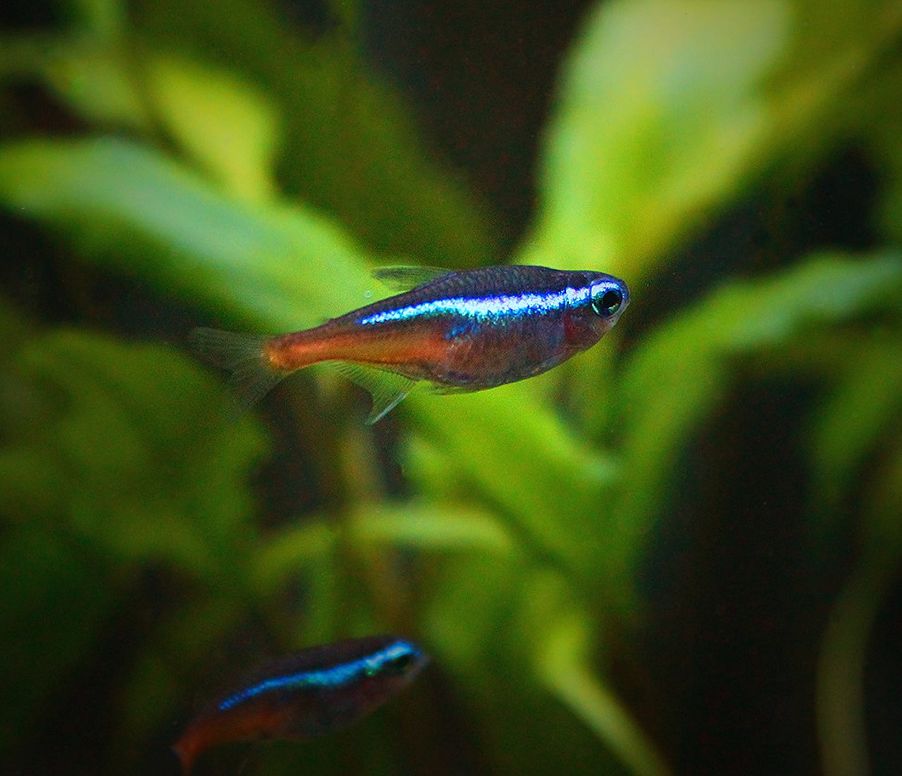
Difficulties in keeping
Care is rather easy. Even aquarists beginners can keep neon tetras if they have a tank with settled conditions. These fishes are bred for sale in high numbers and, correspondingly, they have become highly adaptive to different tank conditions.
Also is not demanding as for the feed and it’s very good tempered. But, again – all above mentioned is true, if your tank conditions are settled and balanced.
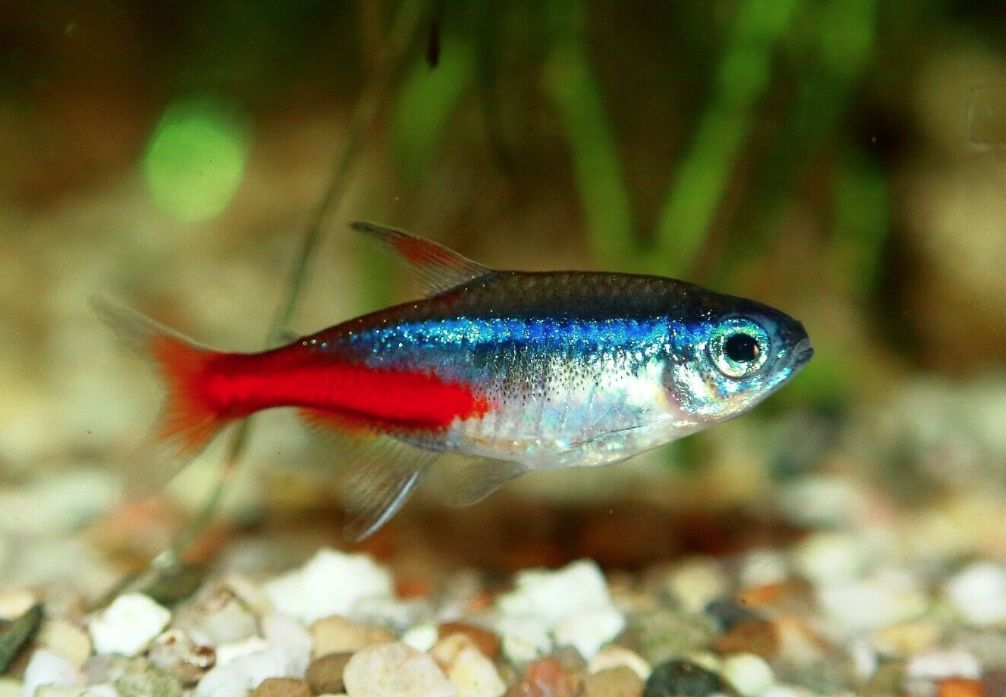
Care and keeping in a tank
Tank size
Neon tetras are small fish, but they are active and social, so providing them with adequate space is essential for their well-being and happiness. The minimum tank size for a school of neon tetras is generally recommended to be around 10 gallons (approximately 38 liters). However, if possible, it’s even better to provide them with a larger tank, as it allows for more swimming space and a more stable environment.
Keep in mind that the tank size should accommodate not just the neon tetras but also any potential tank mates. In a larger tank, you can also create a more natural-looking environment with ample vegetation and hiding spots, which the neon tetras will appreciate. A larger tank is also easier to maintain, as it provides a more stable water environment and allows for better dilution of waste products. This can lead to healthier fish and reduce the frequency of water changes.
In summary, while the minimum tank size for neon tetras is around 10 gallons, providing them with a larger tank (e.g., 20 gallons or more) is highly beneficial and allows for a more enjoyable and thriving aquarium experience.
Water parameters
Neon tetras are sensitive to water conditions, so it’s crucial to maintain stable and appropriate water parameters in their aquarium. A new designed aquarium won’t do for neon fish, since it’s very sensitive to the changes that will occur in this tank later. You should put the neon tetra into a tank only if it has settled conditions and they don’t change rapidly. If any parameter is out of the recommended range, take appropriate actions to correct it gradually. Sudden changes in water conditions can stress and harm the fish.
Always acclimate new neon tetras to the aquarium slowly, as they can be sensitive to changes. Quarantine new fish before introducing them to the main tank to prevent potential diseases from spreading to other tank inhabitants.
Here are the recommended water parameters for neon tetras:
- Temperature: 20°C to 26°C (68°F to 79°F). Keeping the water within this range is important, as neon tetras are tropical fish and thrive in warmer temperatures.
- pH: Slightly acidic to neutral water is preferred, with a pH range of 5.0 to 7.0. It’s essential to avoid significant fluctuations in pH, as sudden changes can stress the fish.
- Water Hardness: Neon tetras are accustomed to soft water conditions. Aim for a general hardness (GH) of 1 to 5 dGH and a carbonate hardness (KH) of 1 to 5 dKH. However, these are ideal conditions, in reality fish can live even in a very hard water, since as we mentioned above – it adapts well to any conditions.
- Ammonia, Nitrite, and Nitrate: Ammonia and nitrite should be kept at zero, as these are highly toxic to fish. Nitrate levels should be maintained at a low level, ideally below 20 ppm (parts per million). Regular water changes are essential to keep these parameters in check.
- Water Movement: Neon tetras prefer gentle water movement, as they come from slow-moving streams in their natural habitat. Using a filter that provides moderate flow or adding a sponge pre-filter to reduce the flow from the filter outlet can be beneficial.
To ensure the water parameters remain stable, it’s essential to perform regular water tests using a reliable aquarium test kit.
Plants
Neon tetras come from habitats with aquatic vegetation, so having live plants in the aquarium mimics their natural environment. The plants provide hiding spots, shelter, and security, which can help reduce stress in the fish. Neon tetras may explore and interact with live plants in the aquarium. They might use the plants as shelter, foraging spots, or even for spawning, which allows them to exhibit more natural behaviors. Some suitable live plants for neon tetra aquariums include Java Moss, Java Fern, Anubias, Cryptocoryne, Amazon Sword, and Hornwort, among others.
Substrate
The tank bottom substrate may be different and with different sized grains, but it’s better for it to be dark colored, because the neon tetra looks better in a tank with such background. Neon tetras come from the Amazon River basin, where the substrate is often covered with fallen leaves and other organic matter. Choosing a natural-looking substrate, such as dark-colored sand or gravel, can help replicate their natural environment.
Decor
In the wild inhabits in dark water with lots of fallen leaves and tree roots on the bottom. It’s important: tank to have a lot of shade areas, where the fishes can hide. Adding driftwood or bogwood to the aquarium not only enhances the natural look but also contributes to the slightly acidic and soft water conditions that neon tetras prefer. These wood pieces also offer hiding places and perching spots for the fish.
Lighting
Neon tetras are most vibrant and comfortable in slightly dim lighting conditions. Consider using a low-intensity aquarium light or adding floating plants to diffuse the light.
Diet
It’s rather easy to feed, since the fish isn’t demanding and it eats all types of feed – live, frozen and artificial. It’s important that the feed has small beadlets, since the neon tetra has a small mouth. Favourite food will be blood worm, tubifex, white worms, brine shrimp.
Here are some recommended foods for neon tetras:
- Flake Food and Pellets: High-quality commercial flake food formulated for tropical fish is the staple diet for neon tetras. Look for a flake food that contains a good balance of protein, fats, and carbohydrates.
- Live Foods: Neon tetras enjoy live foods, which replicate some of their natural prey in the wild. Offer occasional treats of live foods like brine shrimp, daphnia, or mosquito larvae. These can be purchased frozen from most pet stores.
- Frozen Foods: Frozen foods like brine shrimp, bloodworms, and daphnia are excellent options for providing additional nutrition and variety to their diet. These are readily available in many pet stores.
When feeding neon tetras, it’s essential to offer small portions that they can consume within a few minutes. Overfeeding can lead to water quality issues and health problems for the fish. Feed them 2 times a day, adjusting the amount based on how much they eat during each feeding.
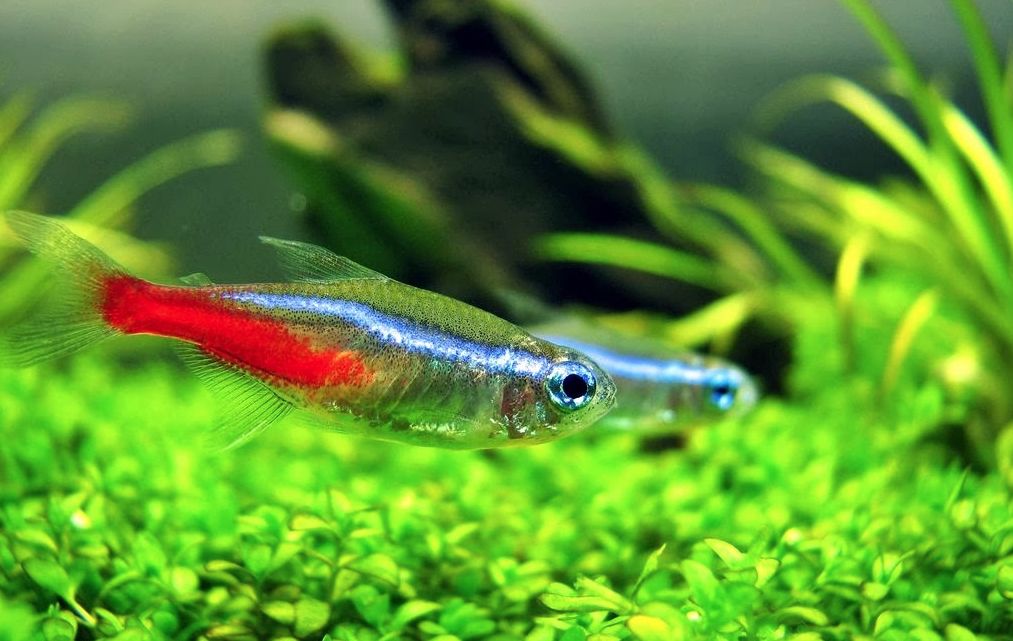
Tank mates
Neon tetra is a peaceful one. If we don’t take into account the peculiarities of its mating season, in general it’s preferable for the neon tetra to have the same peaceful tank mates. This small tetra is an active schooling fish.
It feels most comfortable in a school of about 6 species and it’s where the most bright colors of the neon tetra can be seen. Naturally, that fish shouldn’t be kept in a tank with very battlesome, aggressive or large species.
Tank mates should be ground species, for example, cory. Each of them will swim in its water layer and they won’t disturb each other. At the same time the feed that fish didn’t eat falls on the bottom where the fish can’t see it.
Neon tetra is also a good tank mate for:
- Harlequin Rasboras (Trigonostigma heteromorpha)
- Ember Tetras (Hyphessobrycon amandae)
- Glowlight Tetras (Hemigrammus erythrozonus)
- Black Neon Tetras (Hyphessobrycon herbertaxelrodi)
- Cardinal Tetras (Paracheirodon axelrodi)
- Rummy Nose Tetras (Hemigrammus rhodostomus)
- Dwarf Gouramis (Trichogaster lalius or Trichogaster chuna)
- Sparkling Gouramis (Trichopsis pumila)
- Celestial Pearl Danios (Danio margaritatus)
- White Cloud Mountain Minnows (Tanichthys albonubes)
- Dwarf Rasboras (Boraras spp.)
- Endler’s Livebearers (Poecilia wingei)
- Guppies (Poecilia reticulata)
- Platies (Xiphophorus spp.)
- Corydoras Catfish (Corydoras spp. – pygmy cory, panda cory, adolfoi catfish)
- Otocinclus Catfish (Otocinclus spp.)
- Bristlenose Plecos (Ancistrus spp.)
However, cichlid fishes like Jack Dempsey or tiger barbus or other large and aggressive fishes will be rather bad tank mates.
Gender differences: male vs female
Distinguishing between male and female neon tetras can be challenging, as they have similar external appearances. Unlike some other fish species, neon tetras do not have obvious physical differences between males and females. However, there are subtle characteristics that might help differentiate them:
- Size: In some cases, female neon tetras can be slightly larger and plumper than males, especially when they are carrying eggs.
- Color Intensity: In certain lighting conditions, female neon tetras may appear slightly rounder, and their colors might appear less intense compared to the brighter and more slender appearance of males.
- Egg Spot: In mature female neon tetras, a small, pale spot called an “egg spot” might be visible near the anal fin. This spot is not present in males.
- Behavior: During breeding periods, females might exhibit more territorial behavior, especially when it comes to choosing a suitable site to lay their eggs. Males may become more territorial and actively chase females during courtship.
However, these differences can be subtle and challenging to observe, especially in a community aquarium setting where they might not be displaying breeding behaviors. The most reliable method to determine the sex of neon tetras is by observing their behavior during breeding periods or by examining the presence of an egg spot in mature females.
Breeding
Breeding neon tetras may be not an easy thing, because special water parameters are required. For successful breeding a separate tank with soft water 1-2 dGH and pH 5.0 – 6.0 is required.
The thing is that if the tank water is more hard eggs don’t get inseminated. The capacity of the tank shouldn’t be large, for one couple 10 liters will be enough, for several couples – 20 liters will do.
Put a sprayer that creates minimal flow in the spawning pond and cover it, since during their spawning period the neon tetras may jump out of the tank.
Cover the tank side walls with paper to lessen the amount of light that gets inside. Water temperature should be 25C. As for the tank plants, it’s better to use moss – female will lay the eggs there.
The tetra couple should be fed with live feed and it’s desirable to keep it separately for a week or two. When the couple is put into the spawning pond there shouldn’t be any light in it at all – this can be done at night, since the spawning begins early in the morning.
Neon tetra male will haunt the female that will lay about 100 eggs on the tank plants.
It’s also possible to use nylon bast wisp instead of the plants. Right after the spawning the couple is removed from the tank, since they may eat the eggs.
The water level in the tank is decreased up to 7-10 cm high and the tank gets shaded completely – you can put it into a closet for example, because larva is very sensitive to light.
The neon tetra larva appear from the eggs in 4-5 days and 3 days later the fry will start to swim.
To grow properly juvenile needs to breathe the air to fill its swim bladder, so make sure that the water surface wouldn’t have any slime on it.
The neon tetra juveniles are fed with very small sized feed – infusorian and egg yolk. Gradually you should add some water into the tank to make the water harder.
It’s important not to have any filters there, since juveniles are very small and they die in them.
Disease
The most common disease is Neon Tetra Disease (NTD) or pleistophora disease. This is an infectious disease. It was first identified in neon tetras, but it can also impact other fish like cardinal tetras, black neon tetras, and other characins. Plistiphora hyphessobryconis fungus which infects the muscles is an etiologic agent of this disease. If you suspect Neon Tetra Disease in your aquarium, it’s best to isolate and remove the affected fish immediately to prevent further spread.
Sadly, there is no cure for this disease.
This infection can get into the tank by different ways: with water, shellfish, instruments and fishes from another tank that has been already infected. Neon Tetra Disease is highly contagious and can spread rapidly through a community aquarium. The parasite can be transmitted through infected fish or contaminated water, as well as via cannibalism (eating dead or infected tank mates). Once a fish is infected, it is challenging to treat effectively, and the disease often leads to death.
Infected fish has the following symptoms:
- Fading Colors: Infected fish may lose their vibrant colors, and their bodies may appear pale or washed out.
- Lateral Line Deformity: The disease often causes the fish’s lateral line to become deformed or appear wavy.
- Curved Spine: Infected fish may develop a curved or arched spine, leading to a hunched appearance.
- Abnormal Behavior: The affected fish might exhibit erratic swimming patterns, loss of coordination, and difficulty maintaining their balance.
- Emaciation: As the disease progresses, infected fish may become skinny or emaciated due to their inability to eat properly.
There are some medicines that only slow down the germ number increase, but they don’t eliminate them completely. The deplorable result is, that if pleistophora disease was found in your tank all fishes must be destroyed, no matter how sorry you feel for them.